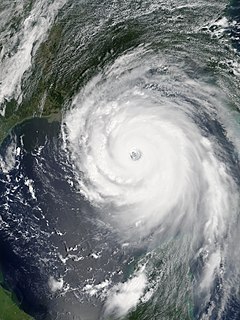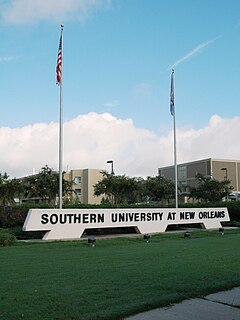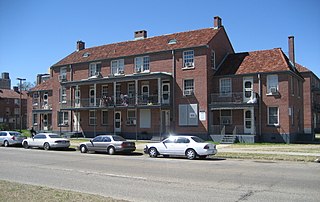
The United States Court of Appeals for the Fifth Circuit is a federal court with appellate jurisdiction over the district courts in the following federal judicial districts:

Hurricane Katrina was a large and destructive Category 5 Atlantic hurricane that caused over 1,800 fatalities and $125 billion in damage in late August 2005, especially in the city of New Orleans and the surrounding areas. It was at the time the costliest tropical cyclone on record and is now tied with 2017's Hurricane Harvey. The storm was the twelfth tropical cyclone, the fifth hurricane, and the third major hurricane of the 2005 Atlantic hurricane season, as well as the fourth-most intense Atlantic hurricane on record to make landfall in the contiguous United States.
Hurricane Katrina had many social effects, due the significant loss and disruption of lives it caused. The number of fatalities, direct and indirect, related to Katrina is 1,833 and over 400,000 people were left homeless. The hurricane left hundreds of thousands of people without access to their homes or jobs, it separated people from relatives, and caused both physical and mental distress on those who suffered through the storm and its aftermath, such as Post-traumatic stress disorder (PTSD).

Southern University at New Orleans is a public historically black university in New Orleans, Louisiana. It is a member of the Southern University System and the Thurgood Marshall College Fund.

The Magnolia Projects, officially the C. J. Peete Public Housing Development, was one of the Housing Projects of New Orleans. As part of the ongoing redevelopment, the area has been renamed Harmony Oaks. The project was among the largest, housing approximately 2,100 people. It is also home to numerous hip-hop artists; it has been referred to as "Magnolia: Home of the Soulja." Located in the part of uptown New Orleans known as Central City, it was bounded by Louisiana Avenue, South Claiborne Avenue, La Salle Street and Washington Avenue. The Magnolia Projects are located within the 11th and 12th Wards of New Orleans. At its height, the Magnolia projects had 1403 units.
The Housing Authority of New Orleans is a housing authority in New Orleans, Louisiana, tasked with providing housing to low-income residents.
Desire Projects was a housing project located in the Ninth Ward of New Orleans, Louisiana. These projects were the largest in the nation and consisted of about 262 two-story brick buildings, containing about 1,860 units across 98.5 acres of land. The overall conditions of the projects were deplorable from the moment they were put into place in the later part of the 1950s. The projects were meant to serve the large number of underprivileged African American residents in the New Orleans area. Soon it became a place of despair, and Desire eventually evolved into a dark no-man’s land, leaving many residents infested with problems and little or no help from the government. Located in a cypress swamp and dumping ground, Desire was known as the poorest housing development in New Orleans—-it was bordered by railroad tracks, the Mississippi River, the Industrial Canal and a corridor of industrial plants. Historically the Desire was the city's most dangerous housing project and was documented as being one of the deadliest communities in the country. Most of the crime was due to drugs like Heroin that have plagued the project since the late 1960s. When crack cocaine arrived in the mid-1980s, the crime rate in the Desire increased, and violence intensified. As residents began moving out to flee the physical and social decay, abandoned apartments provided convenient places to stash drugs; drug deals and killings were commonplace. Desire's alleys and courts became a place where life was sometimes worth less than a pair of basketball shoes. The uptick in murders gave Desire a reputation for violence along with the nearby Florida Projects. In 1995, murders drastically decreased in the Desire project and the Florida development. The nightly gunfire that frequently shattered sleep in the Desire was largely gone; so were the outsiders who once grouped menacingly in the courtyards. That same year in February the U.S. Department of Housing and Urban Development approved a HOPE VI grant to HANO to improve the living environment through rehabilitation of the housing. Mass demolition began in 1997 and was by Complete razed by 1999.

The Melpomene Projects, officially called the Gustavo Apartments, is located in Central City New Orleans and is one of the Housing Projects of New Orleans. The complex occupies ten city blocks, bounded roughly by South Robertson Street, Clio Street, Simon Bolivar Avenue and Martin Luther King, Jr. Boulevard. There were four three-story buildings and two four-story buildings for families and a high-rise for the elderly. At a peak height of 12 stories, the Guste high-rise is the tallest public housing complex in the city.

The Lafitte Projects were one of the Housing Projects of New Orleans and were located in the 6th Ward of New Orleans Treme neighborhood. It was one of Downtown New Orleans' oldest housing developments and had many associated problems before being severely flooded and damaged during Hurricane Katrina in 2005. The project made national headlines after the gruesome murder of Thomas May who burned to death in the project in 1994. By a Department of Housing and Urban Development (HUD) decree, the projects were demolished and redeveloped as affordable, mixed-income housing. The redevelopment effort was charged with replacing every demolished unit. The large housing project was left mostly vacant following evacuations after the extensive flooding from Hurricane Katrina. Heated arguments have surrounded the demolition of the project, as some longtime residents wanted them renovated.

Iberville Projects was a neighborhood in the city of New Orleans and one of the low-income Housing Projects of New Orleans. The Iberville was the last of the New Deal-era public housing remaining in the city. Its boundaries were St. Louis Street, Basin Street, Iberville Street, and North Claiborne Avenue. It is located in the 6th ward of downtown New Orleans, on the former site of the Storyville district. The area has recently been redeveloped into a modernized apartment complex called the Bienville Basin Apartments.
Hexing a Hurricane is a 2006 documentary film about the effect of Hurricane Katrina on New Orleans. It has been billed as the "First Katrina documentary" released by a New Orleanian. The film is directed by Jeremy Campbell and distributed by the National Film Network. The film's score was orchestrated by New Orleans artist Eric Laws.
Kerri Rigsby and Cori Rigsby (Moran) are the American sisters who worked for eight years at E.A. Renfroe Company and were managers overseeing catastrophe claims adjusters. Kerri and Cori Rigsby are also the whistleblowers who proved to a Mississippi jury that State Farm committed fraud against the U.S. government. The sisters claim State Farm ignored or minimized wind damage to avoid payments relating to Hurricane Katrina and instead attributed damage to flooding so that the National Flood Insurance Program would cover the claims. The jury verdict was upheld by the U.S. Court of Appeals for the Fifth Circuit, was then affirmed 8-0 by the United States Supreme Court. The Rigsbys were managers who worked in Gulfport, Mississippi for a subcontractor hired by State Farm to adjust wind and flood claims after Hurricane Katrina. They were the first to uncover a fraudulent scheme by State Farm to improperly categorize wind damage as flood damage. This mischaracterization was very important because State Farm had to pay for wind damage out of its own pocket under State Farm homeowner policies, while flood damage was paid by the federal government under FEMA's flood policies. Over the course of several months, the sisters amassed thousands of pages of documents related to State Farm's activities. The Rigsbys' landmark win was historic because they were the first to prove that an insurance company defrauded the government in FEMA's National Flood Insurance Program despite testimony by FEMA’s Executive Director that, after investigating the allegations, he personally didn’t believe that there was any fraud by State Farm, and he confirmed that FEMA had not asked State Farm to repay any money to the National Flood Insurance Program. However, according to court documents, the sisters took the documents without authorization. Their actions in regard to these documents is the subject of ongoing legal action. Eventually, their story went public when ABC's 20/20 show aired it in August 2006. In 2008, Judge Senter of the U.S. District Court of the Southern District of Mississippi found that the sisters and their attorneys had acted unethically when the Scruggs Katrina Group paid the sisters $150,000 per year each to testify, and barred them from testifying or using any of the documents that were taken. Scruggs was later forced to withdraw as their attorney because he improperly paid them for downloading and giving him the State Farm claims files and other documents to use in his lawsuits against State Farm. Scruggs also was later disbarred after pleading guilty to conspiracy to bribe a state circuit court judge in 2008 and separately, to improperly influence another state court circuit judge. He was sentenced to serve five years and seven years, to run concurrently, on the two guilty pleas.

Internally displaced persons in the United States are people from the Gulf States region in the southern United States, most notably New Orleans, Louisiana, who were forced to leave their homes because of the devastation brought on by Hurricane Katrina in 2005 and were unable to return because of a multitude of factors, and are collectively known as the Gulf Coast diaspora and by standard definition considered IDPs. At their peak, hurricane evacuee shelters housed 273,000 people and, later, FEMA trailers housed at least 114,000 households. Even a decade after Hurricane Katrina, many victims who were forced to relocate were still unable to return home.
The Logan Fontenelle Housing Project was a historic public housing site located from 20th to 24th Streets, and from Paul to Seward Streets in the historic Near North Side neighborhood of Omaha, Nebraska, United States. It was built in 1938 by the Public Works Administration for housing working-class families. With the loss of thousands of industrial jobs in the 1950s and 1960s, the project became filled with families on welfare. As problems increased in the 1970s and 1980s, Logan Fontenelle was referred to as "Little Vietnam" because of drug dealing and gang violence. After Logan Fontenelle residents won a 1991 civil rights lawsuit brought against the Omaha Housing Authority and the U.S. Department of Housing and Urban Development, HUD tore down the projects in 1995 to replace them with new, lower density housing.
Innovative Emergency Management (IEM) is a Research Triangle Park, North Carolina-headquartered disaster management company founded in 1985. It is headed by CEO Madhu Beriwal. IEM has eleven offices strategically located around the United States. Their areas of specialty include homeland security and emergency management, information technology, defense support, and program integration support.
John M. Barry is an American author and historian who has written books on the Great Mississippi Flood of 1927, the influenza pandemic of 1918, and the development of the modern form of the ideas of separation of church and state and individual liberty. He is a professor at the Tulane University School of Public Health and Tropical Medicine and Distinguished Scholar at Tulane's Bywater Institute.
The United States Army Corps of Engineers is involved with a wide spectrum of public works projects: environmental protection, water supply, recreation, flood damage and reduction, beach nourishment, homeland security, military construction, and support to other Governmental agencies. In nineteen (19) different Flood Control Acts since 1917, the United States Congress has authorized the corps to design and build flood protection projects and one risk reduction system in the Greater New Orleans area and throughout the nation.
Communist Party of the United States v. Subversive Activities Control Board, 351 U.S. 115 (1956) and 367 U.S. 1 (1961), was a federal court case in the United States involving the compelled registration of the Communist Party of the United States, under a statute requiring that all organizations determined to be directed or controlled by the "world Communist movement" publicly disclose detailed information as to their officers, funds, and membership.

New Faubourg Lafitte is a residential development in New Orleans, Louisiana, U.S.A. It largely occupies the area formerly filled by the since demolished Lafitte Projects public housing.









